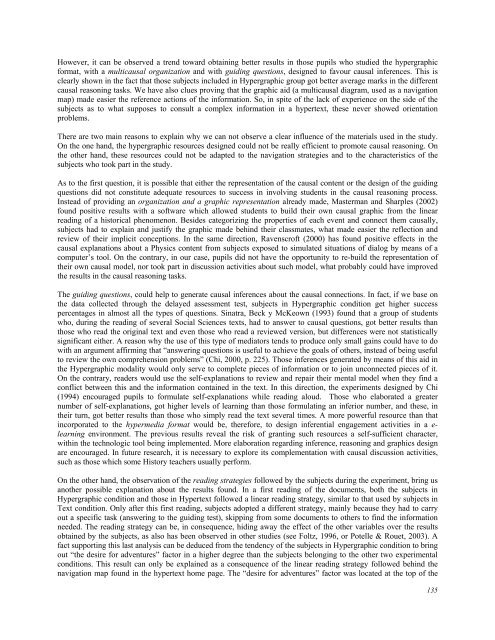Hypergraphics for history teaching - Educational Technology & Society
Hypergraphics for history teaching - Educational Technology & Society
Hypergraphics for history teaching - Educational Technology & Society
Create successful ePaper yourself
Turn your PDF publications into a flip-book with our unique Google optimized e-Paper software.
However, it can be observed a trend toward obtaining better results in those pupils who studied the hypergraphic<br />
<strong>for</strong>mat, with a multicausal organization and with guiding questions, designed to favour causal inferences. This is<br />
clearly shown in the fact that those subjects included in Hypergraphic group got better average marks in the different<br />
causal reasoning tasks. We have also clues proving that the graphic aid (a multicausal diagram, used as a navigation<br />
map) made easier the reference actions of the in<strong>for</strong>mation. So, in spite of the lack of experience on the side of the<br />
subjects as to what supposes to consult a complex in<strong>for</strong>mation in a hypertext, these never showed orientation<br />
problems.<br />
There are two main reasons to explain why we can not observe a clear influence of the materials used in the study.<br />
On the one hand, the hypergraphic resources designed could not be really efficient to promote causal reasoning. On<br />
the other hand, these resources could not be adapted to the navigation strategies and to the characteristics of the<br />
subjects who took part in the study.<br />
As to the first question, it is possible that either the representation of the causal content or the design of the guiding<br />
questions did not constitute adequate resources to success in involving students in the causal reasoning process.<br />
Instead of providing an organization and a graphic representation already made, Masterman and Sharples (2002)<br />
found positive results with a software which allowed students to build their own causal graphic from the linear<br />
reading of a historical phenomenon. Besides categorizing the properties of each event and connect them causally,<br />
subjects had to explain and justify the graphic made behind their classmates, what made easier the reflection and<br />
review of their implicit conceptions. In the same direction, Ravenscroft (2000) has found positive effects in the<br />
causal explanations about a Physics content from subjects exposed to simulated situations of dialog by means of a<br />
computer’s tool. On the contrary, in our case, pupils did not have the opportunity to re-build the representation of<br />
their own causal model, nor took part in discussion activities about such model, what probably could have improved<br />
the results in the causal reasoning tasks.<br />
The guiding questions, could help to generate causal inferences about the causal connections. In fact, if we base on<br />
the data collected through the delayed assessment test, subjects in Hypergraphic condition get higher success<br />
percentages in almost all the types of questions. Sinatra, Beck y McKeown (1993) found that a group of students<br />
who, during the reading of several Social Sciences texts, had to answer to causal questions, got better results than<br />
those who read the original text and even those who read a reviewed version, but differences were not statistically<br />
significant either. A reason why the use of this type of mediators tends to produce only small gains could have to do<br />
with an argument affirming that “answering questions is useful to achieve the goals of others, instead of being useful<br />
to review the own comprehension problems” (Chi, 2000, p. 225). Those inferences generated by means of this aid in<br />
the Hypergraphic modality would only serve to complete pieces of in<strong>for</strong>mation or to join unconnected pieces of it.<br />
On the contrary, readers would use the self-explanations to review and repair their mental model when they find a<br />
conflict between this and the in<strong>for</strong>mation contained in the text. In this direction, the experiments designed by Chi<br />
(1994) encouraged pupils to <strong>for</strong>mulate self-explanations while reading aloud. Those who elaborated a greater<br />
number of self-explanations, got higher levels of learning than those <strong>for</strong>mulating an inferior number, and these, in<br />
their turn, got better results than those who simply read the text several times. A more powerful resource than that<br />
incorporated to the hypermedia <strong>for</strong>mat would be, there<strong>for</strong>e, to design inferential engagement activities in a elearning<br />
environment. The previous results reveal the risk of granting such resources a self-sufficient character,<br />
within the technologic tool being implemented. More elaboration regarding inference, reasoning and graphics design<br />
are encouraged. In future research, it is necessary to explore its complementation with causal discussion activities,<br />
such as those which some History teachers usually per<strong>for</strong>m.<br />
On the other hand, the observation of the reading strategies followed by the subjects during the experiment, bring us<br />
another possible explanation about the results found. In a first reading of the documents, both the subjects in<br />
Hypergraphic condition and those in Hypertext followed a linear reading strategy, similar to that used by subjects in<br />
Text condition. Only after this first reading, subjects adopted a different strategy, mainly because they had to carry<br />
out a specific task (answering to the guiding test), skipping from some documents to others to find the in<strong>for</strong>mation<br />
needed. The reading strategy can be, in consequence, hiding away the effect of the other variables over the results<br />
obtained by the subjects, as also has been observed in other studies (see Foltz, 1996, or Potelle & Rouet, 2003). A<br />
fact supporting this last analysis can be deduced from the tendency of the subjects in Hypergraphic condition to bring<br />
out “the desire <strong>for</strong> adventures” factor in a higher degree than the subjects belonging to the other two experimental<br />
conditions. This result can only be explained as a consequence of the linear reading strategy followed behind the<br />
navigation map found in the hypertext home page. The “desire <strong>for</strong> adventures” factor was located at the top of the<br />
135
















